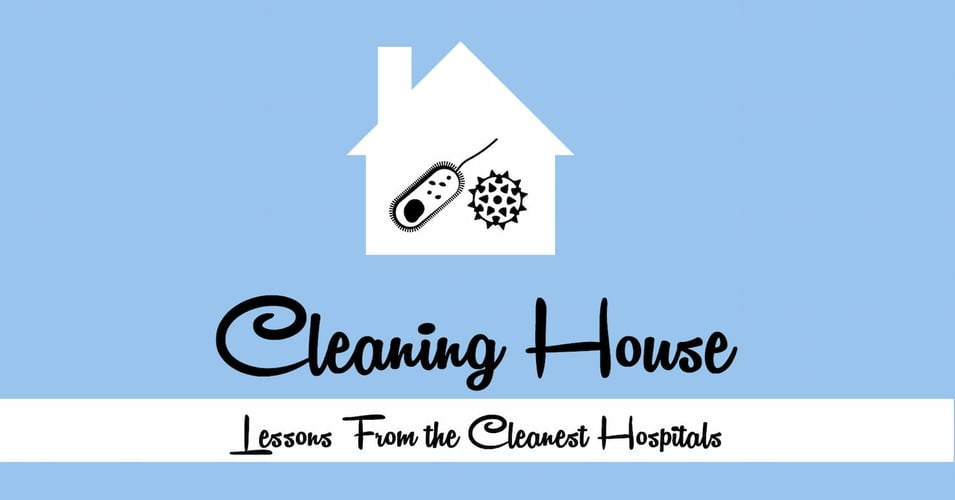How NOT to Clean a Hospital Room

A surprising product recall this week might remind healthcare workers of a known risk in hospital infection control and prevention: The contamination of cleaning supplies with dangerous bacteria (Clorox Pinesol Recall 2022). While most laypeople may not know this is even a possibility, infection preventionists know that cleaning solutions and equipment must be properly maintained or else insidious bacteria will find a way to colonize it. This recall brings to mind the other cleaning errors that hospitals work to prevent. In today's post, we will explore the most common mistakes made in cleaning and disinfecting a hospital room.
Procedural Mistakes
Not cleaning before disinfecting. Before a surface can be disinfected, all biological debris must be removed from the surface. Disinfecting is a two-step process.
Not using fresh cloths or wipes frequently enough. A large area needs more than one wipe. A wipe that is used for too much area loses its germ-killing solution and becomes simply a bacteria-mover.
Not wiping down high-touch surfaces between cleanings or shared equipment between patients. High-touch surfaces are the most contaminated surfaces in a patient room and should be wiped down several times between daily cleaning. Shared equipment will become a traveling bacteria spreader if not wiped down thoroughly between patients.
Not using a systematic way to make sure hard-to-reach areas are cleaned. The best way to make sure all the corners, ledges, and edges get cleaned is to have a systematic way to clean each piece of furniture or equipment. Systematic procedures would ensure that the "cleanest to dirtiest" order was followed.
Not cleaning keyboards and not using keyboard covers. We all know keyboards become sticky, grimy, crumbly pits of nastiness. Keyboard must be part of the cleaning routine, and ideally, they should be covered with a seamless keyboard cover that can be wiped easily.
Product Mistakes
Not using the right product for the right job or at the right concentration. Color coding, fill lines, and other visual cues will help make sure the right chemical and/or equipment is used for the job.
Not following dwell time requirements. Every liquid cleaner may be different, but they all have required durations of time the product must remain wet on the surface ("dwell times") to achieve the public health claims such as "kills 99.9% of bacteria." Some liquids are sanitizers when left wet for 3 minutes but disinfectants when left wet for 10 minutes. Some newer disinfectants have brought the disinfectant time to 2-3 minutes, but even that shorter time is often ignored.
Leaving a wipes container open or cleaning solution in open container. Even slightly dried out wipes have lost efficacy against microorganisms. The wipes container should be reclosed each time, and discarded after use. Cleaning solutions allowed to remain in an open container such as a bucket can become contaminated, going on to spread bacteria with every swipe of the mop.
Not integrating new products and technologies with EPA-registered public health claims. There are EPA-registered products that can help hospitals keep patient areas free from bacterial contamination without additional human sources. Not taking advantage of these products, or investing in those without EPA registration, means patient areas have significantly more bioburden.
Training and Staff Support Mistakes
Not training environmental services personnel (EVP) in how to effectively clean around patients and visitors. It can be awkward to clean a room with people present. If EVP are not specifically given strategies and opportunities to rehearse these strategies, they will inevitably run into situations where their tendency to not want to disturb the patient will impede their ability to clean. Providing helpful phrases ("I need to make sure all surfaces here are safe for the patient." "I need to clear off this table to make sure there is no bacteria left on the table.") can help them inform the patient and/or visitors why their work is important to keeping them/their loved one safe.
Not providing enough personal protective equipment and training for staff. For EVP to remain safe and not become a source of infection themselves, they must be provided the correct PPE to do the job. One of the leading causes of staff turnover in environmental services is the feeling of being unsafe when working around contagious patients. Providing the necessary equipment as well as sensitive training about risks are wise investments. Having the PPE in abundant supply is also important in order to facilitate the needed changing between patients, but the supplies must also go hand-in-hand with training that EVP do not need to "save" or "conserve" supplies, using them over and over in order to not "waste".
A deep dive into what is needed to clean a hospital room is daunting. EVP have to know what to clean and with what product and in what order, how to handle contaminated materials including disposal, how to protect themselves in the process and all the while balancing work with interactions with hundreds of patients and visitors. In the high-pressure environment of a hospital, it is no wonder mistakes are made - we are only human. Innovative products are needed that help cover the gaps left by inevitable human error. Thankfully, biocidal materials like copper and copper-infused EOSCU are available. These surfaces continuously kill microorganisms and keep bacteria levels in the safe zone between cleanings, and because they work independently and indefinitely, they don't make mistakes! Are there cleaning mistakes that you think should be on our list? Add them in the comments below!
![EOScu Logo - Dark - Outlined [07182023]-01](https://blog.eoscu.com/hubfs/Eoscu_June2024/Images/EOScu%20Logo%20-%20Dark%20-%20Outlined%20%5B07182023%5D-01.svg)

![[infographic] Most Touched and Most Contaminated Surfaces in a Patient Room Download and share!](https://no-cache.hubspot.com/cta/default/216314/interactive-178379385229.png)



